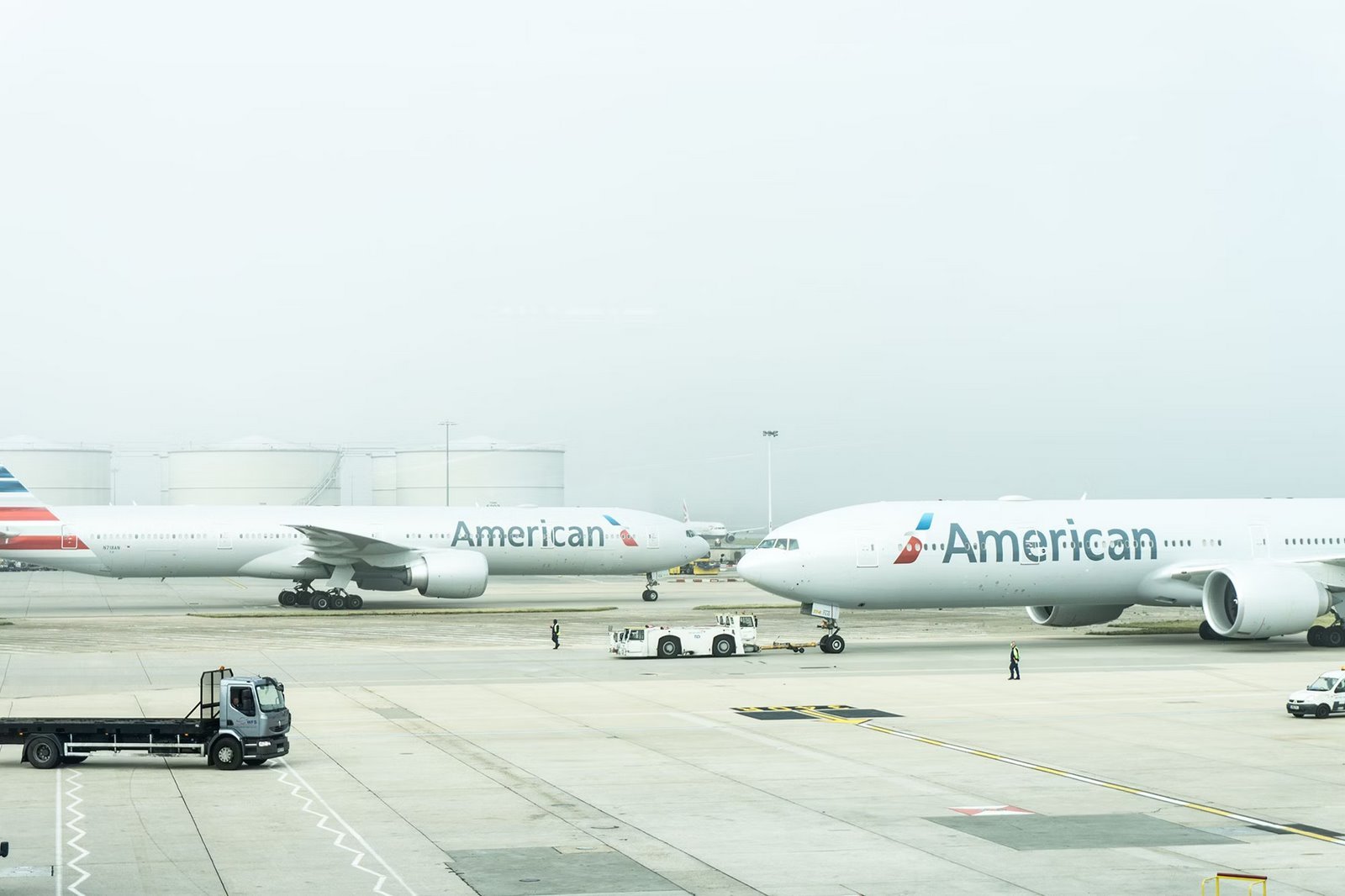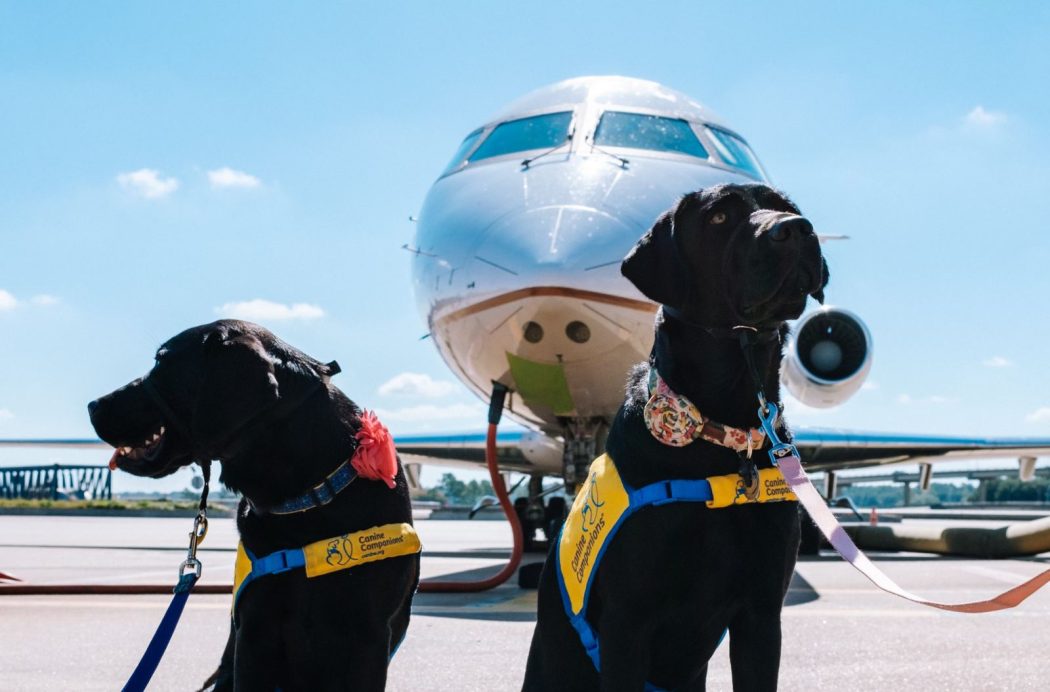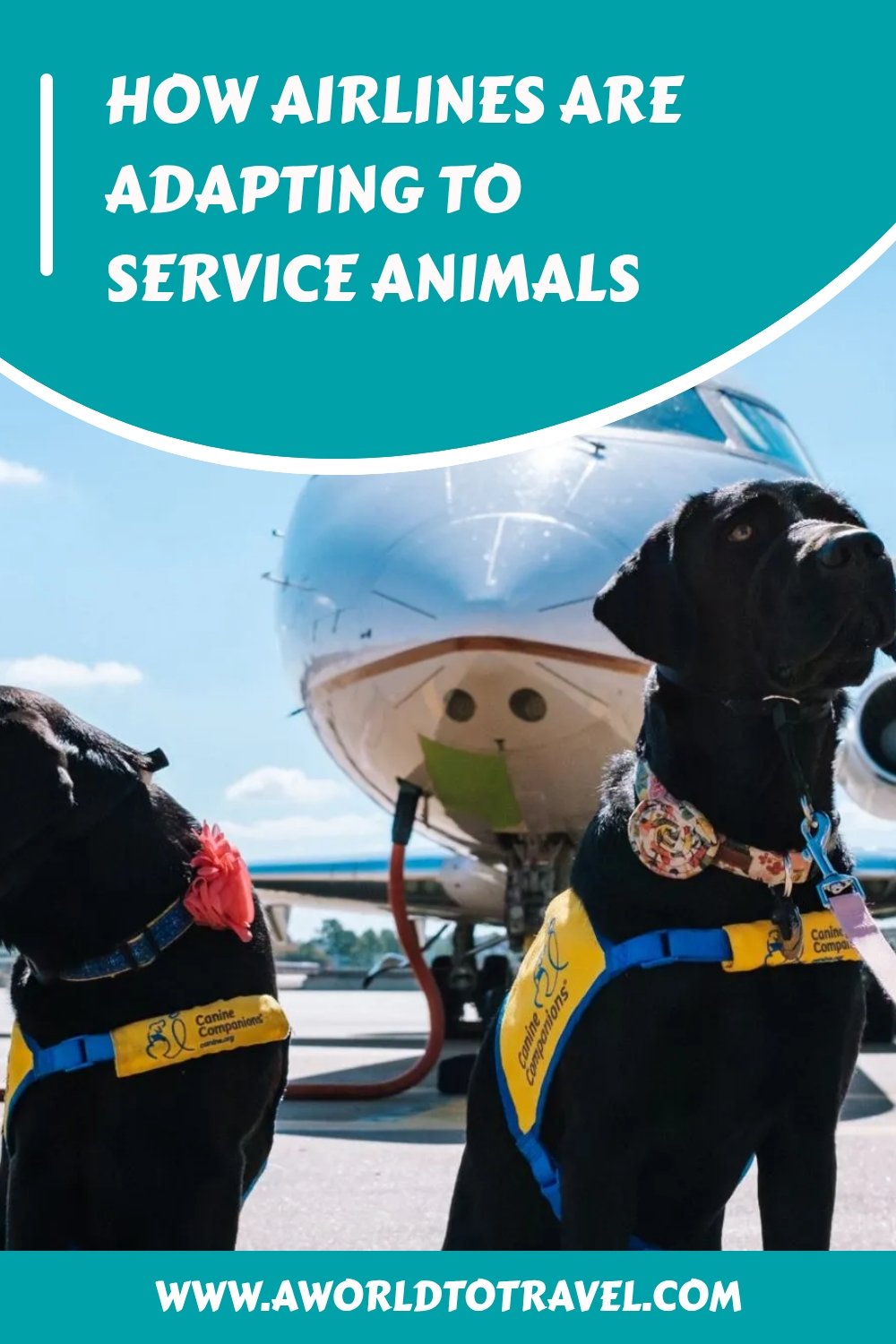Flying with a service animal isn’t what it used to be. Thanks to updated U.S. Department of Transportation (DOT) rules, emotional peacocks and miniature horses are officially out on most airlines. However, you can still book highly trained dogs. If you’re traveling with a service animal or sitting near one, it helps to understand how airlines navigate these changes and what rights and responsibilities apply. Consider these aspects of airline travel when booking your next trip with your paw support.
Contents
- 1. What Is a Service Animal?
- 2. How Do Airlines Accommodate a Service Animal?
- 3. New Rules for DOT Regulations
- 4. Individual Airline Carriers and Service Animals
- 5. Destinations With Special Rules
- 6. Preparing Your Service Animal for Flying
- 7. Tips for Successfully Flying With Your Service Dog
- 8. More Questions About Flying With Your Service Animal
- Flying With Your Service Animal Takes Planning
1. What Is a Service Animal?

The Air Carrier Access Act (ACAA) defines a service animal as a dog that is trained to assist people who have disabilities. These tasks can include physical, sensory, psychiatric, intellectual and mental assistive actions to help their owners cope.
The definition of the ACAA means that emotional support animals, which are untrained pets, are excluded from the list. Therefore, you can’t insist on your pet pig getting into the cabin with you, no matter how much they calm you during takeoff or landing.
Sadly, many people abused the concept of a service animal to get their pets a free plane ticket, as they can’t be denied access. As a result, stricter regulations now limit this privilege to highly trained canines, though many airlines still object to letting a “dangerous” breed like a pitbull or giant-sized dog in the cabin.
While not all airlines are required to let pets board, some may let passengers book passage for them under the same requirements as service animals. However, this isn’t your right, and you’ll have to pay a fee for pets to travel onboard.
2. How Do Airlines Accommodate a Service Animal?
When you travel with a service dog, the airline must allow them to fly in-cabin and free of charge, unlike pets, which often incur fees and may be restricted to crates. Airlines must also allow them to accompany their handler throughout the airport and onto the aircraft, even when pets aren’t permitted such access.
These dogs don’t usually need to be crated, but as with most public spaces like national parks, they must remain harnessed or tethered. They should fit in your foot space, under your seat or on your lap during the flight if they are the size of a 2-year-old child.
While you may see viral videos of people flying with their Great Danes on the seat next to them, this isn’t a legal right or standard procedure. Usually, the dog must not obstruct traffic, and airlines won’t accommodate them in the emergency exit row. Airlines are required to help you relocate within your same class if your service animal doesn’t fit, but they don’t have to bump up your ticket to a more spacious class, so keep your dog’s size in mind when booking.
If there’s no space for your dog, the airline may ask that you fly later or check the dog into cargo, but most handlers will choose a different flight instead.
Big no-nos when flying with a service dog include:
- Short-nosed dogs that hyperventilate and may experience respiratory problems, especially in summer. These are banned by several airlines to avoid liabilities.
- Dogs biting, barking, lunging at passengers or cabin crew, or excessively whining.
- Cabin staff or passengers asking that your dog “prove” they are professionally trained through a demonstration or that you explain your disability to justify flying with one.
- Insisting on sitting in a specific row or that your dog sits next to you on a seat, even if it’s vacant.
- Flying with a sick dog.
3. New Rules for DOT Regulations
You’ll need to meet the legal requirements to fly with a service animal, which have changed. Only trained dogs are considered service animals, and emotional support animals don’t qualify for the “free flight” perk. Airlines may require two mandatory forms — a U.S. DOT form stating the animal’s behavioral training and an additional form stating the dog won’t relieve itself on the flight if it exceeds eight hours.
You can submit these forms online or in person when booking, but having a printed copy with you is wise. Airlines can also limit the number of service animals per person to two, though many limit this to one dog per handler. While the DOT’s ruling doesn’t enforce travel by carrier, it’s still safest to do this if your service dog will fit in one under your seat. Ensure your dog is comfortable with confinement in a carrier for the length of the flight, and fit them with an identification tag to keep them safe if they should stray.
4. Individual Airline Carriers and Service Animals

A closer look at different U.S. domestic airlines and how each accommodates service animals can help you plan your next trip. Remember to check with each airline before booking your flight, as requirements change frequently.
| Airline | Forms required | Approval on the day | Questioning or an interview | Restrictions |
| American Airlines | DOT Service Animal Air Transportation Form | Final approval is required prior to boarding, but get a service animal ID, valid for a year, for quick boarding in the future. | Trained staff enquire about the animal, not your disability. | No puppies or eating from trays, and no dogs on seats. |
| Delta Air Lines | DOT Service Animal Air Transportation Form and proof of vaccinations | No need to get approval at check-in. No baggage charge on kennel or dog. | No preflight interview needed beyond the dog’s size assessment. | No eating from seat trays or jumping on seats. The dog must fit on your lap or in your seat footprint. |
| United Airlines | DOT forms or sign up for a MileagePlus® account that stores forms. | No need for approval. Emotional support animals and pets fly in carriers, while service dogs can fly in-cabin and on a leash. | Boarding size assessment. | Allows service animals in training older than four months. |
| Southwest Airlines | DOT Service Animal Air Transportation Form | Check-in counter approval. | Short interview and fact-finding. | Crating is required during takeoff and landing. |
| Alaska Airlines | Proof of vaccinations and DOT forms, submitted through the Service Animal Form Portal, for quicker future check-ins with an ID number. | At-airport check on the service animal’s condition, training and size. | No fact-finding other than initial check-in. | Service animals in training are allowed as and when space allows. |
| JetBlue Airways | DOT Service Animal Air Transportation Form | Size check | Behavior assessment | No eating off trays, dogs only allowed on the floor or your lap, and you forfeit the lie-flat feature in Mint seating. |
| Spirit Airlines | DOT Service Animal Air Transportation Form | Preflight approval is needed. | Size approval and behavior evaluation. | Big Front Seat option available, which includes more space for the service animal on the floor. No dogs allowed on the seat or in the guest space. |
| Frontier Airlines | DOT Service Animal Air Transportation Form | Right of refusal reserved | Refusal may result from a service animal that doesn’t appear trained. | No stipulation given. |
5. Destinations With Special Rules
If you’re flying to Hawaii, your service animal must be vaccinated, microchipped and cleared for rabies to avoid quarantine. When heading abroad, each country has its own entry requirements, which may include a waiting period after a rabies titer test. Start paperwork several months before you fly to ensure you meet your host country’s requirements, especially for destinations like the European Union or Australia.
Whether you’re traveling to Australia for a short visit or a long-term stay, your dog must meet all quarantine requirements, including that they have a complete six-month health record, come from a Group 3 country, and aren’t pregnant or are nursing puppies. None of the banned breeds, which include wolf-dog hybrids and pitbull terriers, will gain entry.
Travel to an EU country, such as Denmark, France or Germany, requires a careful process. This includes a clear medical history for six months, a valid and checked microchip — scanned by the registered vet before giving a rabies vaccination — and a valid vaccination history or 21-day immunity period.
You can follow up with the Animal and Plant Health Inspection Service (APHIS) of the U.S. Department of Agriculture to find more information on your international destination’s requirements. If APHIS can’t advise you, it’s best to check with the host country’s embassy and the airline booking office, which may direct your query.
When you return from abroad with your service animal, you must comply with the dog importation requirements, including presenting a valid rabies serologic titer from a recognized laboratory, or your dog must undergo 28 days of quarantine. Remember that if you are returning from a country with a live rabies outbreak or other zoonotic disease vector, your service animal may have to be quarantined anyway when you return to the States.
6. Preparing Your Service Animal for Flying
Animals can get nervous during takeoff and landing, and when your service dog has to support you, they should be trained to manage their own plane-related anxiety. Your dog needs to be obedient, but they should also remain calm in a chaotic airport environment, ignore other animals, food and distractions, and stay seated or lie down in tight quarters for hours.
Some service animal training schools even simulate airplane cabins to practice boarding procedures, seat behavior, and ignoring food carts or passengers who may not know how to approach a dog. Handlers may train their own dogs or work with organizations like Guide Dogs for the Blind or Canine Companions to ensure they’re plane-ready. Only well-mannered dogs that are task-oriented will qualify as service animals.
7. Tips for Successfully Flying With Your Service Dog
If you’re going on your first flight with your SA, these tips will help you both succeed.
Prepare Early
Submit forms in time to avoid panic and the risk of your service animal being refused admission. Bargain on at least 48 hours for domestic flights, and check the requirements for international destinations with APHIS. Keep all relevant paperwork on your person to avoid delays and drama if your luggage is misplaced.
Pack Wisely
Bring a harness, leash, ID tags, water, treats and cleanup supplies. Even the best-trained dog can become anxious and may have an accident. Consider a collapsible bowl and a calming spray to make your service animal more comfortable. If they are too large for a crate, consider taking a foldable pet mat or bed to make them more comfortable, especially for particularly long flights.
Manage Feeding Times
Avoid overfeeding to prevent nausea or accidents midflight. Keep your dog hydrated, but don’t let them drink so much that they have to urinate in the plane. Alternatively, keep a few canine nappies with you.
Locate Relief Zones
Use the “Where to Go App” on Apple to help you navigate airports for authorized relief zones where your dog can potty between connecting flights.
Ask for Help
Ask for help in navigating the airport if you need it. Many airlines offer an escort to help you find access points, boarding gates and lounges where you and your service animal can relax before your next flight.
8. More Questions About Flying With Your Service Animal
While the law protects service animals and allows them to fly under specific conditions, such as being tethered to their handler, you may still have questions.
How Do I Deal With Airline Confusion About My Service Animal?
Some airline staff may not know how to help people with a service animal board and could deny you or offer resistance. Ask for the Compliant Resolution Official (CRO) if this happens. The CRO is the airline’s expert on disability matters and will assist you in boarding without further challenges. You can also cite the ACAA and DOT regulations for all U.S. domestic flights. You should document the incident and file a complaint with the DOT hotline. It’s essential to remain calm and professional, even if it’s frustrating. Peaceful explanations can get you boarded more quickly.
Can an Airline Deny My Service Dog Based on Its Breed?
Airlines may not discriminate against the dog’s breed or size on domestic flights, though they may ask that you board a different flight based on space availability. For international flights, a host country may refuse entry to specific breeds.
What Happens if My Forms Aren’t Accepted?
The airline can deny your boarding pass, so always confirm acceptance a few days before departure. Always keep a printed copy of the forms and acceptance with you.
Can I Fly With Two Service Dogs?
You can fly with two dogs if they fit into a carrier under your seat or on your lap, but the airlines aren’t required to provide more room.
Do Service Dogs Need to Wear a Vest or ID Tag?
While it’s not necessary to identify your service animal with a vest or tag, these do help answer questions from fellow travelers and cabin crews. When traveling internationally, your dog will also require a microchip and health passport in addition to legal documentation stating they are service animals.
Flying With Your Service Animal Takes Planning
Today’s airport lounges aren’t quite as chaotic as the “emotional support turkey” days. Still, the paperwork and process have added complexity to traveling with a service animal when you have special needs. Flying can still be smooth and empowering with the right prep. Start planning early, know your rights and use your leash appropriately.
–
Jack Shaw is the Senior Outdoors Writer for Modded Magazine. Driven by his passion for writing, Jack loves to traverse the wilderness, travel, and explore the unknown. He has over six years of experience writing professionally and loves engaging in new projects. His works have been published in The Travel Magazine, EcoHotels, Trekaroo, and more.


